Are you concerned about the safety and purity of bamboo food products? Improperly processed bamboo shoots can contain natural toxins, leading to serious health issues for consumers and compliance headaches for businesses. At Ecosourcecn, I’ll walk you through the essential traditional and modern methods we use to guarantee every bamboo product we supply is perfectly safe.
Proper bamboo processing for food safety involves removing natural cyanogenic glycosides through methods like boiling, soaking, or fermentation. Modern industrial methods add critical steps like sterilization, quality control testing, and advanced packaging. This dual approach ensures compliance with international standards like FDA and LFGB, guaranteeing a final product that is both safe, stable, and high-quality for the global market.
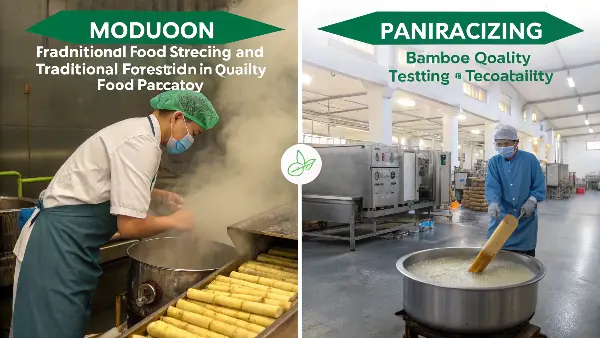
Understanding the journey from a raw plant to a food-grade product is key to appreciating the safety measures involved. It’s a process refined over centuries and perfected by modern science. Both sides are crucial for delivering the quality our partners expect. Let’s start with the most fundamental question: how do you prepare bamboo so people can eat it?
How Do You Actually Process Bamboo for Food?
Have you ever wondered what it takes to turn a tough, raw bamboo stalk into a safe, edible treat? The raw plant is inedible and contains natural compounds that can be harmful, so you cannot simply chop it up and serve it. I’m here to show you the core processing steps, from the moment it’s harvested to when it becomes delicious and safe.
Processing bamboo for food starts with harvesting young shoots and removing the tough outer sheaths. The most critical step is then to boil, steam, or blanch them thoroughly. This heating process deactivates harmful natural compounds, mainly cyanogenic glycosides, making the shoots completely safe to eat. After cooking, they can be canned, dried, or fermented for long-term preservation and flavor enhancement.
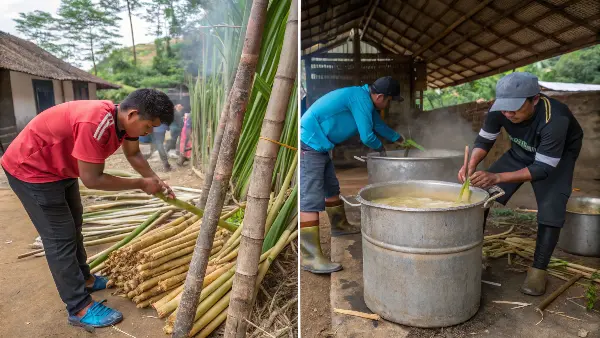
The transformation of bamboo from a wild plant into a safe food ingredient is a meticulous process. As a supplier, we are involved at every stage to ensure quality. It’s not just one step, but a series of carefully controlled actions.
Step 1: Harvesting and Selection
Everything begins in the grove. The timing of the harvest is critical. We only use young bamboo shoots, often called "winter" or "spring" shoots, because they are tender and have the best flavor. Older stalks are too fibrous and woody for consumption. Our local teams know the exact time to harvest each species to ensure peak quality. Once harvested, the shoots are quickly transported to a processing facility. This speed is important to prevent them from becoming tough and to preserve their fresh taste. We inspect the raw shoots upon arrival, rejecting any that show signs of damage, disease, or being too old. This first quality check is fundamental to a good final product.
Step 2: The Critical Cooking Process
This is the most important step for food safety. Raw bamboo shoots are stripped of their multiple layers of tough outer leaves, or sheaths, until the tender, edible core is revealed. This core is then thoroughly washed. Next comes the heat treatment. Boiling is the most common method. The shoots are submerged in water and boiled for at least 20-30 minutes, sometimes longer depending on the size and species. This cooking process does two things: it softens the texture, and more importantly, it neutralizes the natural toxins, making the bamboo completely safe.
Step 3: Final Processing and Packaging
After cooking and cooling, the bamboo shoots are ready for their final form. They might be sliced, diced, or kept whole. From here, they can be canned in brine, vacuum-sealed for fresh sale, dried into thin strips, or fermented. Each of these paths requires additional quality control. For a client like Jacky in Canada who needs products that meet strict regulations, we ensure modern methods like sterilization and controlled packaging are flawlessly executed. We verify that canning processes reach the right temperature to kill any microbes and that packaging is hermetically sealed to prevent contamination.
What Are the Traditional Methods of Bamboo Preservation?
Before factories and canning lines existed, how did people store bamboo for months without it spoiling? This valuable food source was a staple in many cultures, but it would go bad quickly if not preserved. These ancient preservation techniques are not just history; they are clever, natural, and still form the basis of our sustainable practices today.
Traditional bamboo preservation primarily focuses on removing water and creating an environment hostile to microbes. The main techniques are sun-drying, which dehydrates the shoots; brining or pickling in salt and vinegar, which lowers the pH and kills bacteria; and fermentation, which uses beneficial microbes to preserve the shoots while creating unique, complex flavors. These methods are remarkably effective.
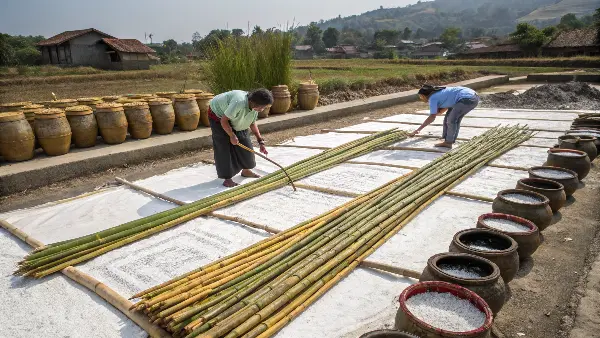
I have always been fascinated by how these traditional methods use simple, natural ingredients to achieve long-term food stability. They are a testament to human ingenuity. At Ecosourcecn, we respect this wisdom and often incorporate these principles into our production chains before applying modern quality controls.
Preservation by Dehydration: Drying
Drying is one of the oldest preservation methods in the world. For bamboo, thin slices of pre-boiled shoots are spread out on mats and left in the sun. The sun’s heat and airflow slowly evaporate the water content. With very little moisture, bacteria, yeast, and mold cannot grow. In some regions, the shoots are smoke-dried over a low fire, which not only preserves them but also adds a deep, savory flavor. Dried bamboo shoots can last for years if stored correctly and must be rehydrated in water before cooking. This method is simple, requires no chemicals, and results in a product with a concentrated, intense flavor.
Preservation by Acidity: Pickling
Pickling is another effective technique. After boiling, bamboo shoots are packed into jars with a liquid that is either very salty (brine) or very acidic (like vinegar). Salt draws water out of the bamboo cells through osmosis, making it harder for microbes to survive. Vinegar creates a low-pH environment where spoilage bacteria cannot multiply. Often, a combination of salt, vinegar, and spices like chili or garlic is used. This not only preserves the bamboo but also infuses it with flavor. Pickled bamboo is a popular condiment and side dish across Asia.
Preservation by Fermentation
Fermentation is a more complex biological process. Pre-boiled bamboo shoots are packed into containers, sometimes with just a little salt, and left to ferment. Naturally present lactic acid bacteria (the same kind found in yogurt and sauerkraut) consume the sugars in the bamboo and produce lactic acid. This acid acts as a preservative and gives fermented bamboo its characteristic tangy, pungent flavor. This method not only preserves the food but can also enhance its nutritional value and digestibility.
| Preservation Method | Key Process | Shelf Life | Flavor Impact |
|---|---|---|---|
| Drying | Removing water content via sun or smoke. | Very Long | Concentrated, sometimes smoky |
| Pickling | Submerging in a high-salt or high-acid solution. | Long | Salty, sour, spicy |
| Fermentation | Using beneficial bacteria to produce lactic acid. | Medium-Long | Tangy, pungent, complex |
Why Does My Stomach Hurt After Eating Bamboo Shoots?
Have you ever eaten bamboo shoots and felt an upset stomach or discomfort afterward? This is a valid concern and it almost always points to one critical issue: the bamboo was not prepared correctly. This is a problem we take very seriously, and I want to explain exactly why it happens and how we guarantee it will never be an issue with our products.
Stomach pain after eating bamboo shoots is most often caused by cyanogenic glycosides, a natural defense compound found in the raw plant. If the bamboo is eaten raw or is undercooked, these compounds can release small amounts of cyanide, causing digestive distress, nausea, or worse. Thoroughly boiling or cooking the shoots for at least 20 minutes completely breaks down these toxins, making them perfectly safe.
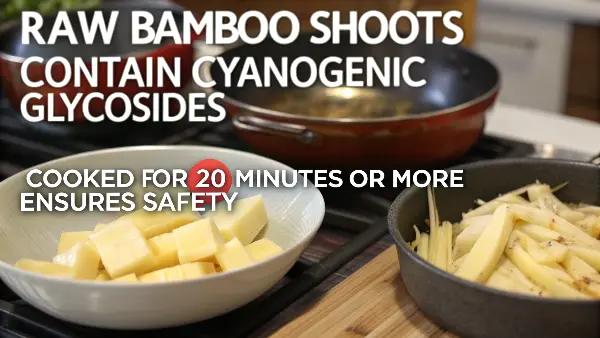
Food safety is not negotiable. For our clients, who are brand owners themselves, serving a product that causes illness is the worst-case scenario. That is why understanding the science behind this issue is central to our quality assurance program.
The Culprit: Natural Plant Toxins
Many plants have natural defense mechanisms to protect themselves from being eaten by animals. In bamboo, the primary defense is a compound called taxiphyllin, which is a type of cyanogenic glycoside. It is harmless in the intact plant. However, when the plant tissue is crushed, chewed, or digested, an enzyme is released that breaks down the taxiphyllin. This reaction produces hydrogen cyanide, a well-known poison. While the amount in bamboo shoots is not typically lethal, it is more than enough to cause unpleasant symptoms like stomach cramps, dizziness, nausea, and vomiting if the shoots are undercooked. This is not a sign of spoilage or contamination; it’s a natural feature of the raw plant.
How Processing Eliminates the Risk
The solution is simple and completely effective: heat. The compounds and the enzymes that activate them are very sensitive to heat. Boiling the bamboo shoots for an adequate amount of time destroys them completely. The toxins are broken down into harmless substances that are then discarded with the boiling water. This is why you will never see raw bamboo shoots for sale in a store. They are always sold pre-boiled, canned, or dried. This non-negotiable cooking step is the single most important part of the entire process for ensuring food safety. As a standard rule, we ensure all our bamboo food products undergo a sustained boiling process that exceeds the minimum time required, adding a layer of safety.
Our Commitment to Toxin-Free Products
For a packaging specialist like Jacky, providing documentation of safety is just as important as the product itself. This is where modern methods become essential. We don’t just rely on the processor’s word. We implement a strict quality control protocol. This includes batch testing to confirm that the cyanogenic glycoside levels are non-existent in the final product. We also ensure our partners adhere to global food safety standards like those set by the FDA and LFGB. Our documentation provides full traceability, from the harvest to the final package, giving our clients complete confidence.
How Do You Make Bamboo Food Products Pest-Proof?
You have safely processed bamboo that is free of toxins, but the job isn’t done. How do you protect it during shipping and long-term storage? Pests like weevils, beetles, and mold can ruin an entire shipment, leading to financial loss and creating new safety risks. The solution lies in a combination of traditional know-how and modern packaging technology.
To make bamboo food products pest-proof for storage and shipping, the key is controlling moisture and using superior packaging. Traditionally, thorough drying and smoking were used. Modern methods are far more precise. We use industrial dryers to achieve a specific low moisture content and then use technologies like vacuum sealing or modified atmosphere packaging. This creates an environment where pests and mold cannot survive.
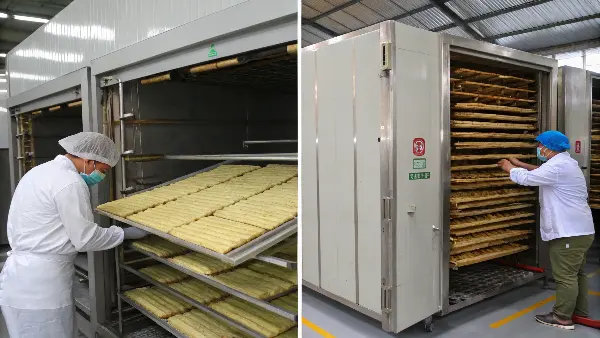
For our partners who manage global supply chains, product integrity upon arrival is everything. A client in Europe or North America needs to know that the product they ordered months ago will be in perfect condition when the container is opened. This is why we focus so heavily on the final preservation and packaging steps.
The Foundation: Moisture Control
Pests and mold need one thing above all else: water. The most fundamental way to make a food product like dried bamboo unattractive to them is to remove the moisture. While traditional sun-drying is a great start, modern industrial dryers give us precise control. We can target a specific, very low moisture content—often below 10%—that makes it impossible for most microorganisms to grow. We use moisture meters to test batches and ensure this critical threshold is met. For canned or pickled products, the liquid they are packed in (brine or vinegar) serves the same purpose by creating an inhospitable environment.
Modern Packaging Solutions for Global Shipping
This is where our expertise becomes critical for a packaging specialist. The right package is an active barrier against pests and environmental factors. Simple plastic bags are not enough. We recommend and use multi-layer packaging solutions to protect the product.
- Vacuum Sealing: Removing all the air from a package suffocates any insects or insect eggs that might be present. It also stops the growth of aerobic bacteria and mold.
- Modified Atmosphere Packaging (MAP): In this process, the air inside a package is replaced with a specific gas mixture, usually a blend of nitrogen and carbon dioxide. This gas mix inhibits pest survival and spoilage without using chemical preservatives.
- Oxygen Absorbers: For many dried products, we add small, food-safe packets that absorb any residual oxygen from inside the sealed package, creating an oxygen-free environment that further guarantees protection.
| Packaging Type | Pest Prevention Mechanism | Best For |
|---|---|---|
| Simple Polybag | Minimal physical barrier. Poor protection. | Short-term, local use only. |
| Vacuum Sealing | Removes oxygen, suffocating pests and inhibiting mold. | Dried bamboo strips, powdered products. |
| Canning/Jarring | Hermetic seal plus heat sterilization kills all life. | Sliced/whole shoots in brine or vinegar. |
| MAP Bags | Replaces oxygen with an inert gas mix to prevent pest life. | High-value or delicate bamboo products. |
These modern packaging methods, combined with clean, climate-controlled warehousing, ensure that when an order from Ecosourcecn arrives, it is as safe and pristine as the day it was packed.
Conclusion
Combining proven traditional preservation techniques with the rigor of modern science is the only way to ensure bamboo food products are truly safe. From boiling away natural toxins to using advanced packaging that prevents pests, every step matters. This comprehensive expertise is what we provide, delivering safe, compliant, and high-quality solutions to our partners worldwide.


